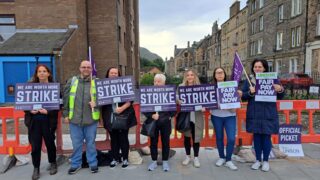Cutbacks in facility time for local government are leaving activists feeling like they are “conducting covert ops” when they represent members who work for another employer, conference heard.
Tracy Lamy-Edwards, Lincolnshire council branch, said facility time had been cut for three years in her authority. “I make sure that any time spent supporting members who do not work for my substantive employer is done during the evening, at weekends or on my holiday time. That has an impact on my health and wellbeing.”
Duncan Smith, City of Edinburgh branch agreed: “Every member who is associated with our branch is entitled to expect the same level of representation. But it is increasingly difficult to provide this. Our council recently said that any branch officers using facility time to represent staff employed by a private employer will face disciplinary action. That is harsh, but it is what we are facing.”
Moving the successful composite motion, Dan Sartin, West Sussex County branch, said: “All of us agree on the need for facility time. All of us agree that attacks on it are political, deplorable and unjustified.
“What we need is practical and immediate support for any branches who face attacks on their facility time.”
For the service group executive, Paul Gilroy said: “Facility time is one of the key resources we rely on to represent our members. It is not time off, it is time to work on behalf of members. Councils have choices about where they make funding cuts and cuts to facility time are short-sighted and will cause them further problems.”
He paid tribute to branches who had fought strong campaigns against attacks on facility time.
One such branch is Swindon local government. Speaking for the branch, Stewart Darke said: “Two years ago the council told us there was a line in the budget we might like to look at. At a stroke it would have removed facility time.
“This was a blatant and cynical attempt to try and destabilise our union. The council seemed to regard the union as some sort of external body. We had to remind them that we were their employees.”
The branch ran a successful campaign and painted a picture to the council of what life would be like with no trade unionists working on facility time – showing how it would slow down negotiations and consultations around change and putting the council at legal risk.





